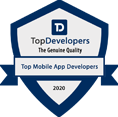The Ultimate Full-Stack Dictionary: A-Z Guide for Developers and Business Analysts

Whether you’re a developer exploring code or a business analyst planning your next Full-Stack development project, understanding tech terms is essential. This Full-Stack Dictionary is your go-to guide, covering key terms from A to Z. Each term is explained with both technical and strategic insights, making it valuable for developers, analysts, and BDEs alike. Dive in and enhance your Full-Stack knowledge today!
Tech Insights for Developers & Business Analysts
A
API—Application Programming Interface
Developer POV: An API is a set of rules that allows different software entities to interact among themselves. A developer uses an API when integrating different systems to provide seamless interactions among various applications.
Business Analyst POV: APIs enable smooth communication between systems, which saves time and money. This reduces redundant operations and the likelihood of errors.
Agile
Developer POV: Agile is a methodology that helps in iterative development, and through collaboration – requirements and solutions evolve. It promotes adaptive planning, evolutionary development, early delivery, and continuous improvement.
Business Analyst POV: Agile methodologies enable flexibility and quick reaction to change, ultimately resulting in better project outcomes and customer satisfaction through the delivery of products that meet dynamic requirements.
B
Backend
Developer POV: The backend is the server side of any application that deals with database interactions and server logic, including the integration of any service. It is the backbone of any web application for handling requests and responses.
Business Analyst Perspective: Understanding the backend is critical to determine how data will be handled and secured to ensure the general functionality and reliability of the application.
Business Logic
Developer POV: This is the set of rules or algorithms that handle the data between a database and a user interface. It’s the most important part of an application that accomplishes business operations.
Business Analyst: Business logic ensures that all the business rules, policies, and procedures are correctly executed, aligning the software functionality with business objectives.
C
CI/CD (Continuous Integration/Continuous Deployment)
Developer POV: The method of frequent application delivery to customers by introducing automation into the stages of application development. Continuous Integration, Continuous Delivery, and Continuous Deployment are the major terms attributed to CI/CD.
Business Analyst: CI/CD reduces the time to market and promotes new features and bug fixes. This improves the general efficiency and reliability of the development process.
Cloud Computing
Developer POV: Cloud computing allows the use of a network of remote servers hosted on the Internet for storing, managing, and processing data without use of local servers.
Business Analyst: Cloud computing offers scalability, therefore supporting the continuity of business operations.
D
Docker
Developer’s POV: Docker is a platform that brings OS-level virtualization to software delivery through a pack that is called a container. Containers are light, portable, and ensure consistency across multiple development and release cycles.
Business Analyst POV: Docker helps make the process of development, testing, and deployment easier, as it assures that applications are going to work reliably despite the environment.
Data Analysis
Developer POV: Analysis of data is a process of inspecting, cleaning, and modeling data with the purpose of finding useful information and deriving conclusions from it. This, in turn, is extremely important for application performance and user experience.
Business Analyst POV: Data analysis provides insight to help make decisions, identify trends, and understand behavior, resulting in better business strategies.
E
Express.js.
Developer’s Point of View: Express.js is a minimalist flexible Node.js web application framework that enables a powerful way of building web APIs. It facilitates the rapid development of Node.js applications.
Business Analyst Perspective: The use of frameworks such as Express.js accelerates the development time and ensures that applications are built with a robust and scalable foundation.
E-commerce
Developers’ Perspective: E-commerce, as we know, enables the online buying and selling of goods or services. This encompasses the development of both front-end interfaces and back-end systems – which integrate various APIs and third-party services. This ensures security and a seamless shopping experience.
Business Analyst: e-commerce is an important business model where goods or services are sold via the internet, requiring careful analysis for the perfecting of user experience and operation efficiency.
F
Front-end
Developer POV: The front-end is the client side of an application, dealing with all that the user is going to deal with directly. Technologies include HTML, CSS, and JavaScript. In short, front-end includes the design, layout and interactivity of the website and translates visual design into a functional and responsive user interface.
Business Analyst: A well-designed front-end ensures good user experience and is critical for customer satisfaction and retention and thus, for your clients too.
Functional Requirements
Developer’s Point of View: Functional requirements will specify what the system shall do, explaining what functionalities and features are to be implemented.
Business Analyst: Functional requirements provide the Business Analyst with a clear and detailed roadmap to guide development in a way where all stakeholders have a shared understanding of the project goals.
G
Git
Developer POV: Git is a distributed version control system that tracks changes in source code during software development. It allows more than one developer to work on the same codebase simultaneously.
Business Analyst POV: Git maintains version control and efficiency of collaboration, which is vital to maintaining project integrity and tracking progress.
Gap Analysis
Developer POV: In software development, gap analysis is the comparison of the current state of a system or process to the desired future state to identify discrepancies and areas needing improvement.
Business Analyst’s Opinion: Gap analysis will help in finding the gaps between the present capabilities and business requirements, which will lead to strategic planning and resource allocation.
H
HTTP/HTTPS
Developer Point of View: HTTP—Hypertext Transfer Protocol—and HTTPS—HTTP Secure—are protocols used for sending information across the web. HTTPS adds a security layer by encrypting the data sent.
Business Analyst: Data transmission security is very critical to ensure protection of sensitive information. The site can be hacked, or data can be stolen – if this standard security procedure is not taken care of.
Hadoop
POV Developer: Hadoop is a framework that is open source, distributed, and can run huge data sets across computer clusters. It uses simple programming models to process big data.
Business Analyst: Hadoop allows for analyzing huge volumes of data, bringing about insights on which business decisions and strategies may be based.
I
Internet of Things, or IoT
Developer POV: We were earlier connected by the Internet of People – where the people are connected through multiple platforms. IoT – Internet of things means – an ocean of devices that will be connected throughout the world – sharing data for quick decision making!
Business Analyst: IoT can allow organizations to innovate business models and services, bringing forward a new basis for connecting with their customers and optimizing their operations.
Impact Analysis
Developer POV: Impact analysis can find what an alteration to the codebase really does to the already-existing system and help the developers anticipate problems.
Business Analyst: Impact analysis is an evaluation of how proposed changes will affect business processes and helps to ensure that benefits outweigh risks.
J
JavaScript
Developer POV: JavaScript is a high-level programming language that is essential for web development, enabling interactive and dynamic content on websites. It is a scripting language. Whenever you see a click-to-show dropdown menu, dynamically changing element colors – or such features – these are the effects of JavaScript. Without JavaScript, you would now see an internet that is pure HTML and nothing else.
Business Analyst POV: Being versatile and in wide use, JavaScript is a must-have technology for any custom web application development that would meet users’ expectations.
JIRA
Developer: JIRA is a tool used for issue tracking and software development project management. It tracks bugs, stories, and tasks.
Business Analyst Viewpoint: JIRA enables the management of projects, thus keeping all team members working together in harmony to deliver projects according to the timeline.
K
Kubernetes
Developer POV: Kubernetes is an open-source platform that automates the deployment, scaling, and operation of containerized applications. It makes applications cluster management easy.
Business Analyst: Kubernetes works for the efficiency and reliability of the deployment of applications, which is critical to keeping the service at its best with optimum operational efficiency.
Kanban
Developer’s Point of View: It is a method for visualizing the management of workflow and tasks within teams.
Business Analyst: Kanban is a very clear visualization of the workflow that helps teams recognize bottlenecks and work for better productivity.
L
Linux
Developer’s point of view: Linux is an open-source operating system characterized by its stability and security features; it’s usually used in server environments and during development.
Business Analyst Point of View: Understanding Linux can help understand the technological environment and be compatible with the business applications.
Load Balancing
Developer POV: Load balancing distributes incoming network traffic across multiple servers, ensuring that no single server is overwhelmed, to improve reliability and performance.
Business Analyst: Effective load balancing ensures the high availability and responsiveness of business-critical applications for enhanced user experience.
M
Microservices
Developer POV: An architectural style that structures an application as a collection of loosely coupled services. The services can be developed, deployed, and scaled independently.
Business Analyst POV: This architecture allows greater agility and scalability to adjust faster to the emergent needs in the business environment.
Market Analysis
Developer POV: Research in the market to know the trends and needs the software must accommodate.
Business Analyst POV: Market analysis provides customer demand insights and competitive landscapes that guide product development and business strategies.
N
Node.js
Developer POV: Node.js is a JavaScript runtime built on Chrome’s V8 engine, allowing developers to build scalable network applications. It enables server-side scripting.
Business Analyst POV: Node.js supports the development of fast, scalable applications, which can enhance user satisfaction and operational efficiency.
NDA (Non-Disclosure Agreement)
Developer POV: NDAs are legal contracts ensuring that proprietary information remains confidential during and after project completion.
Business Analyst POV: NDAs protect sensitive business information and intellectual property, ensuring competitive advantage and legal compliance.
O
OAuth
Developer POV: OAuth is an open-standard authorization protocol that allows users to grant websites or applications access to their information without sharing passwords.
Business Analyst POV: OAuth enhances security and user experience by providing a secure and straightforward authorization method, critical for protecting user data.
Operational Efficiency
Developer POV: Operational efficiency in software development involves optimizing resources and processes to improve productivity and reduce waste.
Business Analyst POV: Improving operational efficiency reduces costs and increases the value delivered to customers, enhancing overall business performance.
P
Python
Developer POV:Python is a high-level, interpreted programming language known for its readability and versatility, widely used in web development, data analysis, and automation.
Business Analyst POV: Python’s ease of use and extensive libraries support rapid development and innovation, aligning with business goals and timelines.
Product Backlog
Developer POV: A product backlog is an ordered list of features, enhancements, and bug fixes that need to be addressed in a product. It guides development priorities.
Business Analyst POV: Managing the product backlog ensures that the development team focuses on delivering features that provide the most business value.
Q
Query Language
Developer POV: A query language, such as SQL, is used to communicate with databases, allowing developers to retrieve, update, and manage data efficiently.
Business Analyst POV: Understanding query languages helps in formulating data extraction strategies, supporting decision-making with accurate and timely information.
Quality Assurance (QA)
Developer POV: QA involves systematic activities to ensure that software meets specified requirements and is free of defects. It includes testing, code reviews, and validation.
Business Analyst POV: QA is critical for delivering reliable and high-quality software products, ensuring customer satisfaction and reducing maintenance costs.
R
REST (Representational State Transfer)
Developer POV: REST is an architectural style for designing networked applications, using simple HTTP requests to interact with resources. It’s widely used for building APIs.
Business Analyst POV: RESTful APIs facilitate seamless integration between different systems, enhancing interoperability and business process automation.
Risk Analysis
Developer POV: Risk analysis in development involves identifying potential issues that could negatively impact project outcomes and devising strategies to mitigate them.
Business Analyst POV: Conducting risk analysis helps in anticipating challenges, ensuring proactive measures are taken to safeguard project success.
S
Scrum
Developer POV: Scrum is an Agile framework that enables teams to work on complex projects through iterative progress and collaboration. It emphasizes regular reflection and adaptation.
Business Analyst POV: Scrum enhances flexibility and responsiveness to change, ensuring that the final product aligns closely with business requirements.
Stakeholder Analysis
Developer POV: Stakeholder analysis involves identifying and understanding the needs and expectations of all parties involved in a project.
Business Analyst POV: Effective stakeholder analysis ensures that the project meets the needs of all stakeholders, fostering support and minimizing conflicts.
T
TypeScript
Developer POV: TypeScript is a superset of JavaScript that adds static typing, making it easier to manage large codebases and catch errors early in the development process.
Business Analyst POV: TypeScript can improve code quality and maintainability, leading to more reliable and scalable applications.
Technical Debt
Developer POV: Technical debt refers to the implied cost of additional rework caused by choosing an easy solution now instead of using a better approach that would take longer.
Business Analyst POV: Managing technical debt is essential for maintaining the long-term health and performance of software, preventing costly future refactoring.
U
UI/UX (User Interface/User Experience)
Developer POV: UI/UX design focuses on enhancing user satisfaction by improving the usability, accessibility, and pleasure provided in the interaction with a product.
Business Analyst POV: Good UI/UX design is crucial for attracting and retaining users, impacting the overall success and profitability of the application.
User Stories
Developer POV: User stories are short, simple descriptions of a feature told from the perspective of the end user, outlining the value they will receive.
Business Analyst POV: User stories ensure that development efforts are aligned with user needs and business goals, facilitating clear communication and prioritization.
V
Version Control
Developer POV: Version control systems, like Git, track changes in source code, allowing multiple developers to work on a project simultaneously without conflicts.
Business Analyst POV: Version control ensures that all changes are documented and reversible, providing transparency and reducing the risk of errors.
Value Stream Mapping
Developer POV: Value stream mapping is a lean management method for analyzing the current state and designing a future state for the series of events that take a product from start to finish.
Business Analyst POV: This technique helps in identifying waste and optimizing processes, leading to increased efficiency and value delivery.
W
WebSocket
Developer POV: WebSocket is a protocol that enables two-way communication between a client and server over a single, long-lived connection, useful for real-time applications.
Business Analyst POV: WebSocket supports features like live updates and instant notifications, enhancing user engagement and experience.
Workflow Automation
Developer POV: Workflow automation involves using technology to automate repetitive tasks, improving efficiency and reducing human error.
Business Analyst POV: Automating workflows can lead to significant cost savings and productivity gains, allowing employees to focus on higher-value tasks.
X
XML (eXtensible Markup Language)
Developer POV: XML is a markup language used for encoding documents in a format that is both human-readable and machine-readable. It is widely used in web services.
Business Analyst POV: XML enables the structured transmission of data across different systems, facilitating interoperability and data integration.
XP (Extreme Programming)
Developer POV: XP is an Agile software development methodology aimed at improving software quality and responsiveness to changing customer requirements through frequent releases in short development cycles.
Business Analyst POV: XP focuses on customer satisfaction and team collaboration, ensuring that the final product meets the user’s needs and business goals.
Y
YAML (YAML Ain’t Markup Language)
Developer POV: YAML is a human-readable data serialization standard used for configuration files and data exchange between languages with different data structures.
Business Analyst POV: YAML’s readability makes it easier to understand and modify configuration settings, improving collaboration between developers and analysts.
Yield Management
Developer POV: Yield management in software involves using algorithms to maximize revenue from a fixed, perishable resource. It’s commonly used in travel and hospitality industries.
Business Analyst POV: Understanding yield management helps in developing pricing strategies and optimizing resource utilization to maximize profits.
Z
Zero Downtime Deployment
Developer POV: Zero downtime deployment involves deploying updates to a live application without causing any interruption to the service, ensuring continuous availability.
Business Analyst POV: This approach ensures that users always have access to the application, improving customer satisfaction and minimizing revenue loss.
Z-Index
Developer POV: Z-index is a CSS property that specifies the stack order of elements, crucial for controlling the layering of content on web pages.
Business Analyst POV: Proper use of Z-index enhances the visual appeal and usability of a website, contributing to a better user experience.
Conclusion
Mastering Full-Stack development starts with understanding the right terms, and this Full-Stack Dictionary has you covered from A to Z. Whether you’re a developer, analyst, or BDE, staying informed is key to success. Ready to take your skills or projects to the next level? Contact us today for expert guidance and support!

















